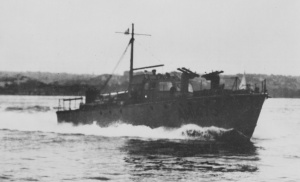HMAS Alatna
| Builder |
Lars Halvorsen & Sons Pty Ltd at Ryde, NSW |
|---|---|
| Commissioned |
2 February 1944 |
| Decommissioned |
1 January 1946 |
| Fate |
Sunk in Balabac Strait 1 January 1946 |
| Dimensions & Displacement | |
| Length | 62 feet |
| Performance | |
| Speed | 20 knots |
HMAS Alatna was an ex-Australian Army fast supply/sea ambulance launch (AM 1475) commissioned, at Sydney, on 2 February 1944 under the command of Lieutenant Hubert Edward ‘Ted’ Carse, RANVR for use by the Services Reconnaissance Department (SRD). Carse had previously commanded Krait during her service on Operation Jaywick; the special forces raid on Singapore in September 1943.
Alatna was 62 feet in length, of plywood construction, weighing 28 tons and capable of 20 knots. She was armed with heavy machine guns and had a crew of eight. Alatna and her sister ships were built by Lars Halvorsen & Sons Pty Ltd at Ryde, NSW during 1943. Propulsion was initially from three Gray marine diesel engines. Three other Army launches were also transferred to the Navy; Karina, Misima and Nyanie.
After arriving in Darwin, Sub Lieutenant William McLeod, RANVR took command of Alatna on 10 March 1944 but she was to have several Commanding Officers over the next 10 months. Alatna, and Krait, were to be used to insert and re-supply small special forces teams on Timor, Sumba and Sabu Islands. During March she explored a number of reefs and islets in the Timor Sea to assess their suitability for use as supply dumps for SRD operations. Alatna proved unreliable for covert SRD activities due to her plywood hull construction, which leaked, and poor quality engines and spent the period April-June 1944 laid-up in Darwin undergoing repairs.
In July 1944 Alatna sailed to set up a supply dump on Ashmore Reef but turned back due to bad weather and an attempted reconnaissance of Roti Island, in August, was thwarted by engine problems. She spent the next six months in and out of maintenance and on 27 January 1945 Sub Lieutenant Thomas Dann, RANVR assumed command of Alatna and was to be her last Commanding Officer.
Alatna commenced a major refit at Darwin in mid-March 1945 which included significant hull maintenance, an overhaul of her wireless telegraphy equipment and the fitting of new main engines. On 21 August she left Darwin, bound for the island of Morotai (Netherlands East Indies) as part of a convoy of small vessels escorted by the corvette HMAS Gympie. The other vessels included HMA Ships Grass Snake, Karina, Krait and Sea Snake and a Royal Navy minesweeper HMS 2046. The convoy arrived at Morotai on 29 August 1945.
The Allied landings on Morotai had commenced in September 1944 and the main fighting concluded in October; but isolated skirmishes with Japanese troops continued until August 1945. The main Australian presence at Morotai was the RAAF who conducted air attacks on Japanese forces in the Southern Philippines. Hostilities had ceased on 15 August 1945, but the area between Darwin and Morotai was still in Japanese hands and they were an unpredictable enemy. Alatna was at Morotai when the surrender of the Japanese 2nd Army (including their forces at Morotai and the nearby Halmahera Islands) was accepted by General Thomas Blamey on 9 September 1945. While at Morotai, Alatna conducted various harbour support and transport duties.
On 12 September Alatna sailed from Morotai bound for Manado, in the Northern Celebes (now Sulawesi), in company with Grass Snake. After four days there (14-18 September), assisting with the evacuation of former Prisoners of War the two vessels sailed to Balikpapan in North Borneo. Here they rendezvoused with the corvette HMAS Inverell and the British warship HMS Eduardo and on the 20th embarked Australian soldiers of the 21st Brigade (7th Division) for transit to Makassar (now Ujang Pandang) in Southern Sulawesi.
This force sailed from Balikpapan on the 21st and arrived at Makassar on the 25th where they disembarked the Australian soldiers to supervise the disarmament of Japanese forces and evacuation of former Prisoners of War. Alatna assisted with the evacuation of the former Prisoners of War; mainly Royal Navy personnel whose ships had been sunk in early 1942. Due to anti-Dutch feelings amongst the local civilian population the larger Allied ships including HMS Maidstone (Submarine Depot Ship) were forced to anchor offshore and the smaller vessels transferred the formers POWs to them. Due to Japanese defensive minefields in the area Alatna also assisted with the pilotage of larger vessels into the port during September and October.
Alatna’s usefulness was now coming to an end and the decision was made to hand her over to the British Borneo Civil Administration. She returned to Balikpapan in mid-December 1945 and was later taken in tow by HMAS Cessnock for the transit to Labuan on the north coast of Borneo. Cessnock handed over the tow of Alatna to HMAS Quickmatch, at Tawitawi Island on 30 December 1945. Quickmatch then headed towards Labuan via the Balabac Strait. While passing through the strait, on the morning of 1 January 1946, the American ship SS Marine Runner was sighted astern of Quickmatch. Inexplicably, as the vessel approached Quickmatch it altered course to cross astern of the destroyer and rammed and sank Alatna and then steamed on without stopping.
Quickmatch slipped the tow as the shattered hulk of Alatna sank and launched her motor cutter and a whaler to rescue the crew. Seven survivors were rescued from the water, but 18 year old Able Seaman Raymond Dodgson, he would have turned 19 the following day, was not found and he was subsequently listed as missing presumed drowned. The destroyer then steamed on to Brunei Bay to disembark the survivors.
An enquiry into the event indicated that the crew of the Marine Runner had not seen Alatna under tow and, after altering course, the bridge was un-manned and no lookouts posted.





